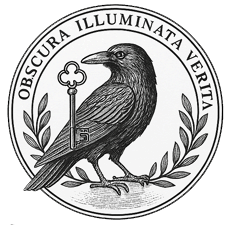The Veins of StormCroft: The Underground Railway
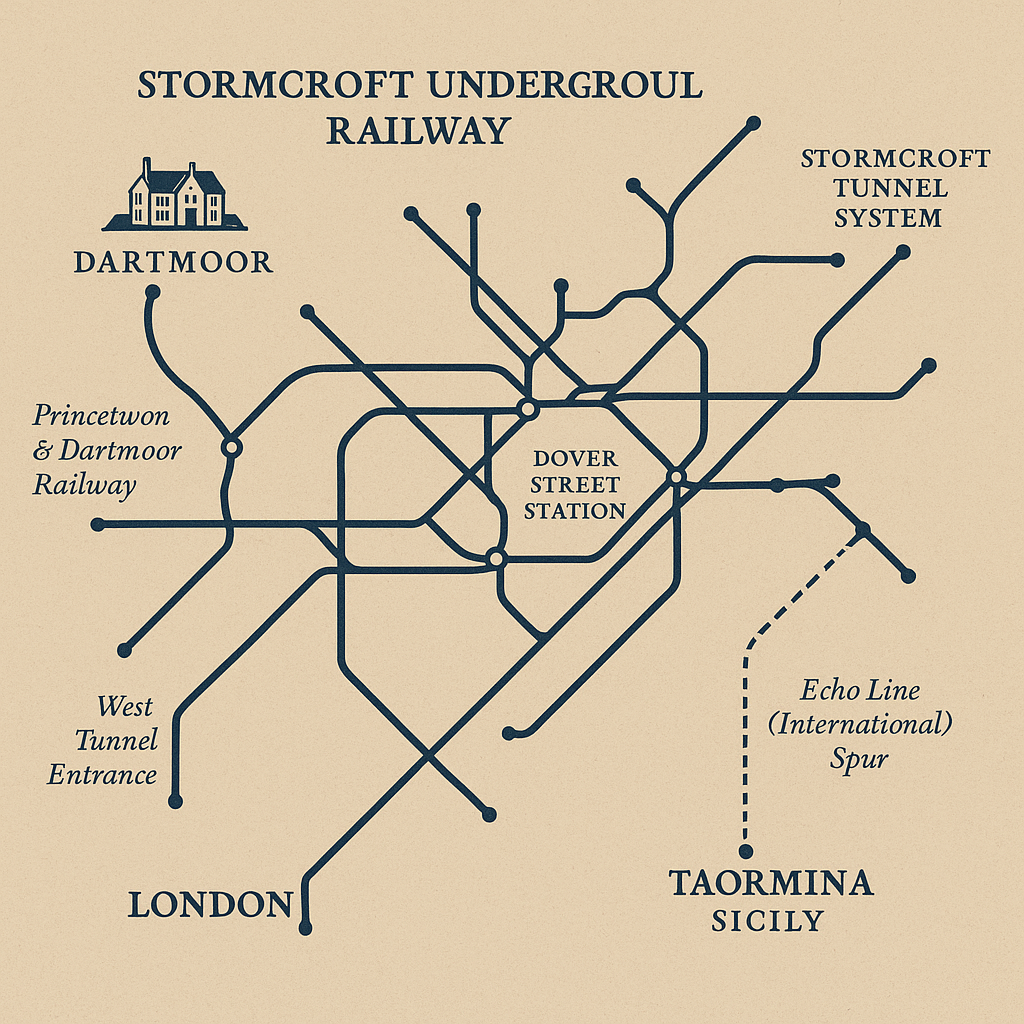 Filed: Vault 3-C / Active Monitoring Tier II
Filed: Vault 3-C / Active Monitoring Tier II
Classification: Structural Intelligence Asset – Operational Legacy
Status: Partially Retained and Reclassed – “Memory-Bound Infrastructure”
“It wasn’t built to move us. It was built so we could be forgotten in transit.”
– Elias Dunbridge, memo dated 12 March 1906
They called it a railway, though there was no ticketing, no platform staff, no clocks. Just the sound of metal below stone, the scent of copper dust in the air, and a corridor that never came back quite the same. StormCroft’s Underground Railway was — and in part, remains — one of the estate’s most closely guarded infrastructures: a subterranean arterial system of conveyance, concealment, and controlled erasure.
Foundations and Design (1860s–1872)
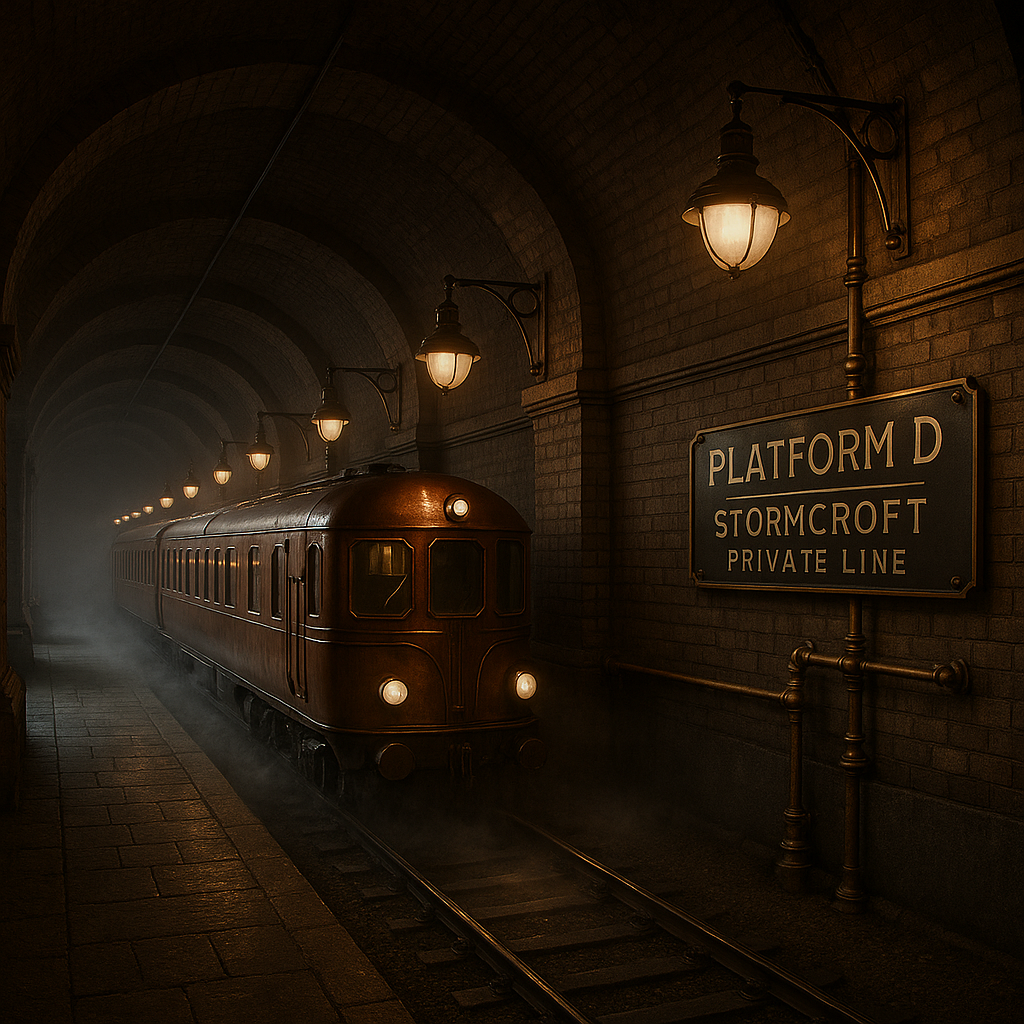
This atmospheric photograph, recovered from the Sub-Vault Image Archive, depicts Platform D, the primary embarkation point of the StormCroft Underground Railway. Taken in 1889, the image captures the arrival of a fog-ready private carriage, its copper body humming with residual energy from earlier Fog Transport linkage.
Gas lamps curve along the vaulted ceiling, illuminating the mist that perpetually clings to the line. The wall-mounted sign confirms this as a restricted route, used exclusively by StormCroft staff and authorized carriers.
Notably, this train type was designed to accommodate both resonance-absorbing compartments and sealed memory crates. Some whisper it once carried “passengers who never boarded” — and cargo that hummed back.
Contrary to public record, the railway under StormCroft House did not follow the construction of the manor — it preceded it. Engineers working under Octavius Wren and Wilber R. Dart were granted discreet access to existing military spur lines initially laid for the Princetown & Dartmoor Railway. These lines, decommissioned on record in the 1850s, were quietly diverted, reinforced with copper-traced timber, and embedded with resonance absorbers.
By 1871, the StormCroft Initiative had repurposed three levels of tunnel:
-
Primary Line: Connecting the StormCroft Boiler Sub-Hall to the Moor Intake Loop (T-North)
-
Inner Sidings: Dead-end holding bays used for biological cargo, sealed crates, and “non-verbal passengers”
-
Spur Extension East: Direct link beneath the StormCroft conservatory to the restricted Vaulted Rail Slip known as Doorline 3
In 1872, the final integration was made: a copper-lined door appeared overnight in the rear boiler room, unmarked except for a single iron rivet, warm to the touch.
The Dover Street Connection (London Underground)
StormCroft’s most infamous external rail nexus was — and still is — Dover Street Station, later renamed Green Park on the London Underground. Opened in 1906 as part of the Great Northern, Piccadilly and Brompton Railway, the station was selected due to its precise geological convergence with old StormCroft schematics.
StormCroft Fact: Beneath Dover Street Station exists a floor sealed with 32 bolts. Behind it lies the Croft Crossover Line – unrevealed in any London Underground engineering document.
Between 1906 and 1933, at least nine confirmed StormCroft movements passed through this tunnel, including:
-
The fog-escorted return of Elias Dunbridge after the 1920 containment failure
-
Transit of the “vocal crates” recovered from Room 11-S
-
Three extraction events involving compromised informants from the War Office
Dover Street’s eventual renaming to Green Park was not a rebranding — it was a disassociation protocol to sever public inquiry. A 1937 internal StormCroft memo reads:
“The signal still travels. Only the station forgets it.”
In 1981, London maintenance discovered a sealed copper alcove during electrical upgrades beneath Green Park. It was never opened.
The Taormina Spur: Sicily’s Silent Echo
Far from the mists of Dartmoor, the Taormina Spur stands as StormCroft’s most ambitious underground extension — a tunnel that curves from England’s southern substructure into the very soil of eastern Sicily.
Linked Station: Taormina-Giardini (Opened 1866)
Tunnel Reference: “Linea Silenziosa”
First confirmed transit: 3 August 1884
Unlike the domestic segments of the railway, the Sicilian connection bypassed physical border protocols, employing a combination of Fog Transport augmentation and what internal logs called “earth-looped phase blending” — a method that allowed the tunnel to exist partially out of phase with fixed terrain.
Known Use Cases:
-
Transfer of stone glyph tablets recovered from Etna-adjacent caves
-
Secret meetings with the silent branch of the CroftNet Network (based in Palermo)
-
Removal of Finch’s failed Annulet prototypes following a containment breach
“The tunnel was warm, like the breath of history. And the walls tasted like memory.”
– Jonathan Hales, unofficial quote from unfiled letter, 1887
Following the partial collapse of the Sicilian vault in 1932, the route was closed from the Italy side. StormCroft staff continued to hear ocean sounds through the floor of the unused tunnel until the mid-1950s.
Integration of Fog Transport
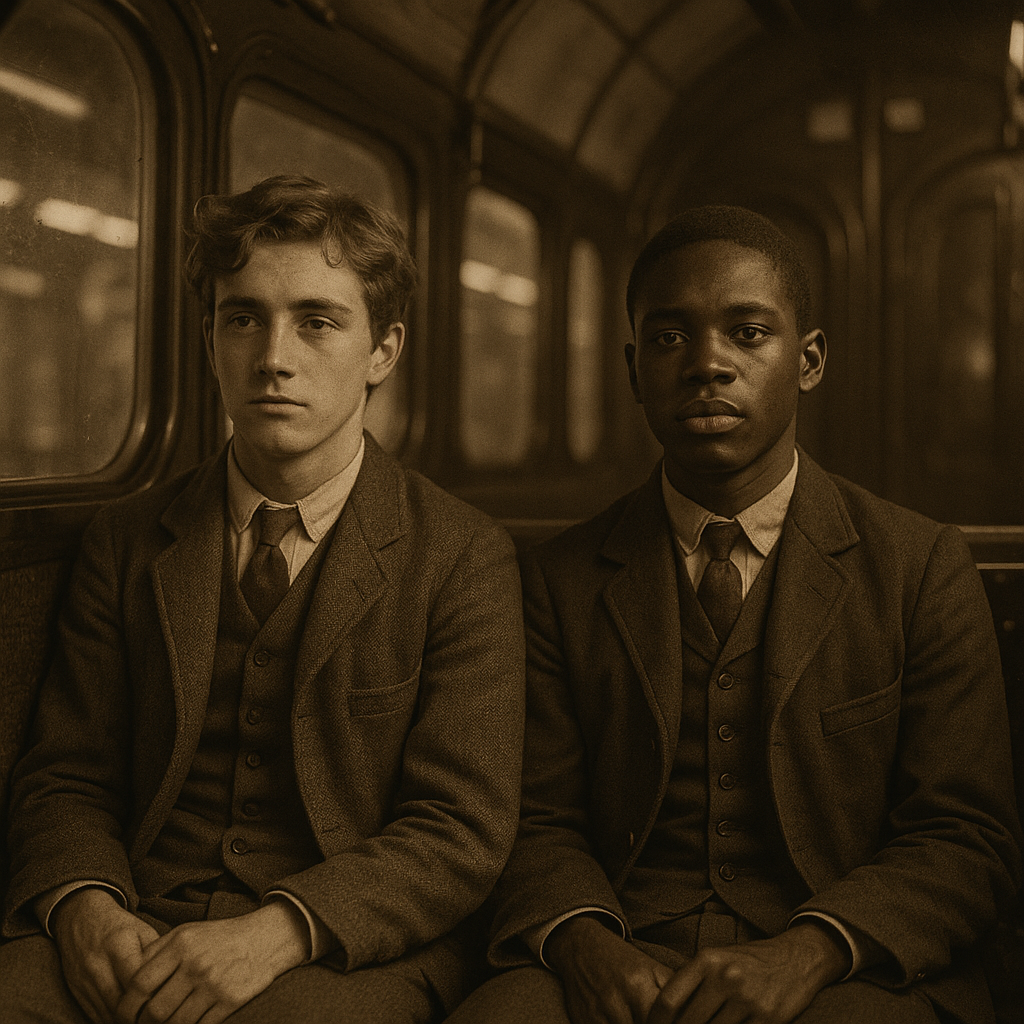
This sepia-toned photograph captures a rare moment inside a StormCroft underground railway carriage during active service in 1882. Two passengers — one white and one Black — are seated opposite each other in the soft gloom of the copper-lit compartment. The design reflects StormCroft’s unique integration of fog-resistant materials and dampened sound panels.
The figure on the left is believed to be Alton Reys, aged 15 at the time, en route to a southern vault station for linen processing reassignment. The identity of the second passenger remains unconfirmed in the archives, though annotations suggest he was a junior steward attached to the Boiler Intake Wing.
A faint hum, said to linger beneath the floorboards, was noted in the carriage log. The door behind them bore a sigil believed to prevent “unrecorded exits.”
The brilliance of the Underground Railway was not simply its engineering, but its seamless pairing with Fog Transport. This link was not incidental — fog conduits were embedded directly into select carriages.
These “ghost trains” (so named for their lack of vibration) travelled the tunnels under conditions of:
-
Full atmospheric pressure drop
-
Corridor saturation with copper mist and rosemary oil
-
Zero illumination
Fog Trains departed without notice and arrived without memory. Several passengers described:
-
Entering with four companions and exiting alone
-
Having lost all sense of time but found their pockets full of soil
-
A warm ticking heard just below the floorboards for hours afterward
In a 1939 incident, an unmanned fog train was found idling in the StormCroft sidings. The seats were wet. One passenger manifest was found, with all names erased but one: “Subject K.”
Decommissioning and Afterlife
Portions of the Underground Railway were sealed in 1956, following multiple echo overlaps in the east vault and the unexplained absence of two fog dispatchers. However — and this is critical — much of the line remains intact.
Retained Segments Include:
-
T-North to Boiler Hall Line (now sealed with salt-bonded iron)
-
Doorline 3 Corridor (under surveillance)
-
CroftNet Docking Spur (intermittent signal logged as late as 1984)
In 1996, a researcher noted steam rising from a ventilation grate near the bell corridor. No boilers were active.
Final Notes – StormCroft Internal Codex
-
Dover Street remains the only London terminus with direct historic access
-
Taormina is no longer monitored, but the Silent Line’s copper tracing still carries voltage
-
Fog Transport devices now exhibit residual activation when placed near tunnel floorboards
-
Whisper logs from 2001 recorded faint train whistles at 03:03 AM on the equinox
“The line is not past. It is not future. It is the breath between.”
– CroftNet Phrase Archive, Vault Fragment 88Q-B
Overlay of Real-World Maps: StormCroft’s Underground Railway
1. Princetown & Dartmoor Railway (Devon, England)
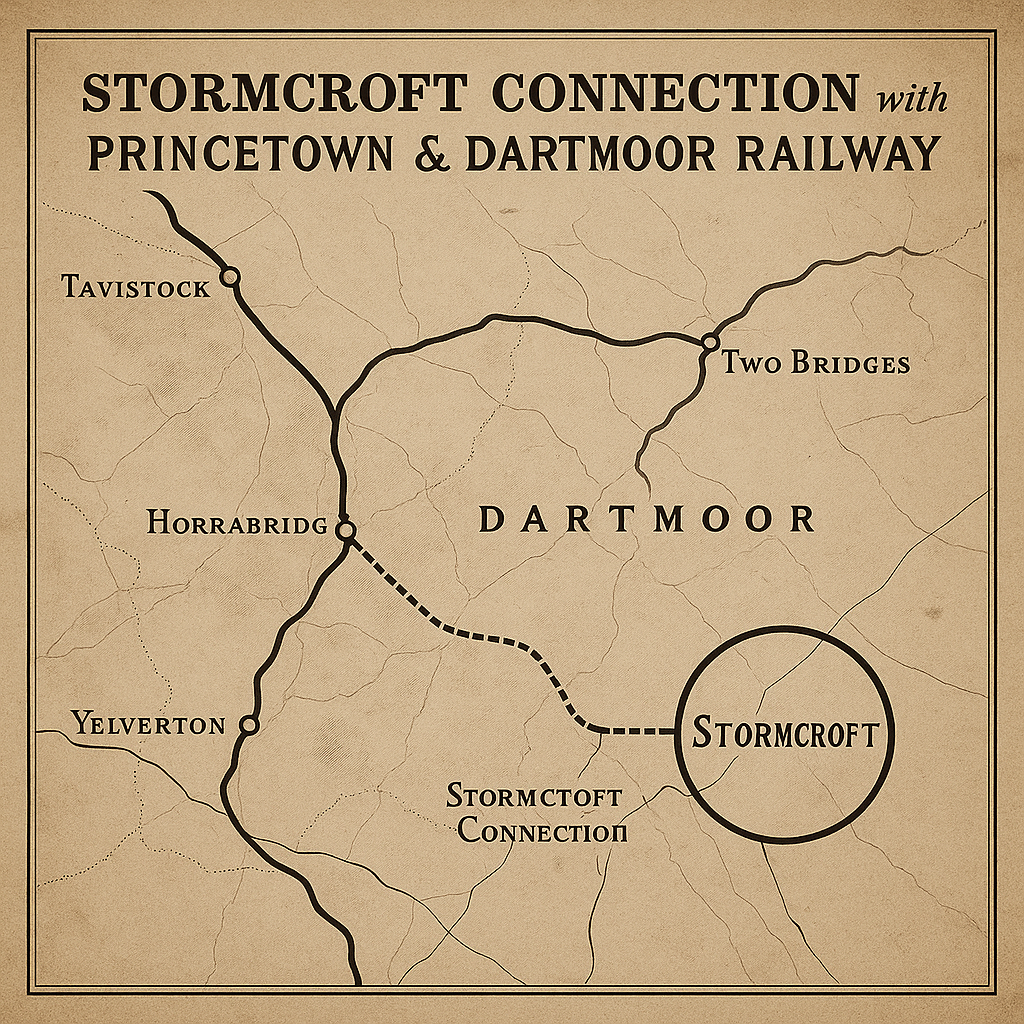
The Princetown Railway was a 10¼ mile single-track branch line in Devon, England, operating from Yelverton to Princetown. It served Dartmoor Prison and nearby granite quarries, with intermediate stations at Dousland, Burrator and Sheepstor Halt, Ingra Tor Halt, and King Tor Halt. The line closed in 1956 and now forms part of a popular walking and cycling route.
Map Reference: Historical maps of the Princetown Railway can be found in the National Library of Scotland’s collection, providing detailed layouts of the line’s course through Dartmoor.
Image Description:
This vintage-style schematic map illustrates the secret linkage between the StormCroft Underground Railway and the official Princetown & Dartmoor Railway. The map highlights known public stations such as Yelverton, Dousland, and Princetown, alongside the StormCroft Branch Line, which diverges just east of Burrator & Sheepstor Halt.
The hidden spur — labelled “S-Line: Internal Access Route” — dips beneath the moor, reaching StormCroft House via Tunnel T-North, and includes undocumented sidings used for containment cargo, covert travel, and resonance-sensitive equipment.
Faint lines at the base indicate non-surface continuation, possibly leading toward further networked passages or decommissioned fog chambers. The map was discovered in a tinplate filing box dated July 1886, stamped with the StormCroft seal.
2. Dover Street Station (Now Green Park), London Underground
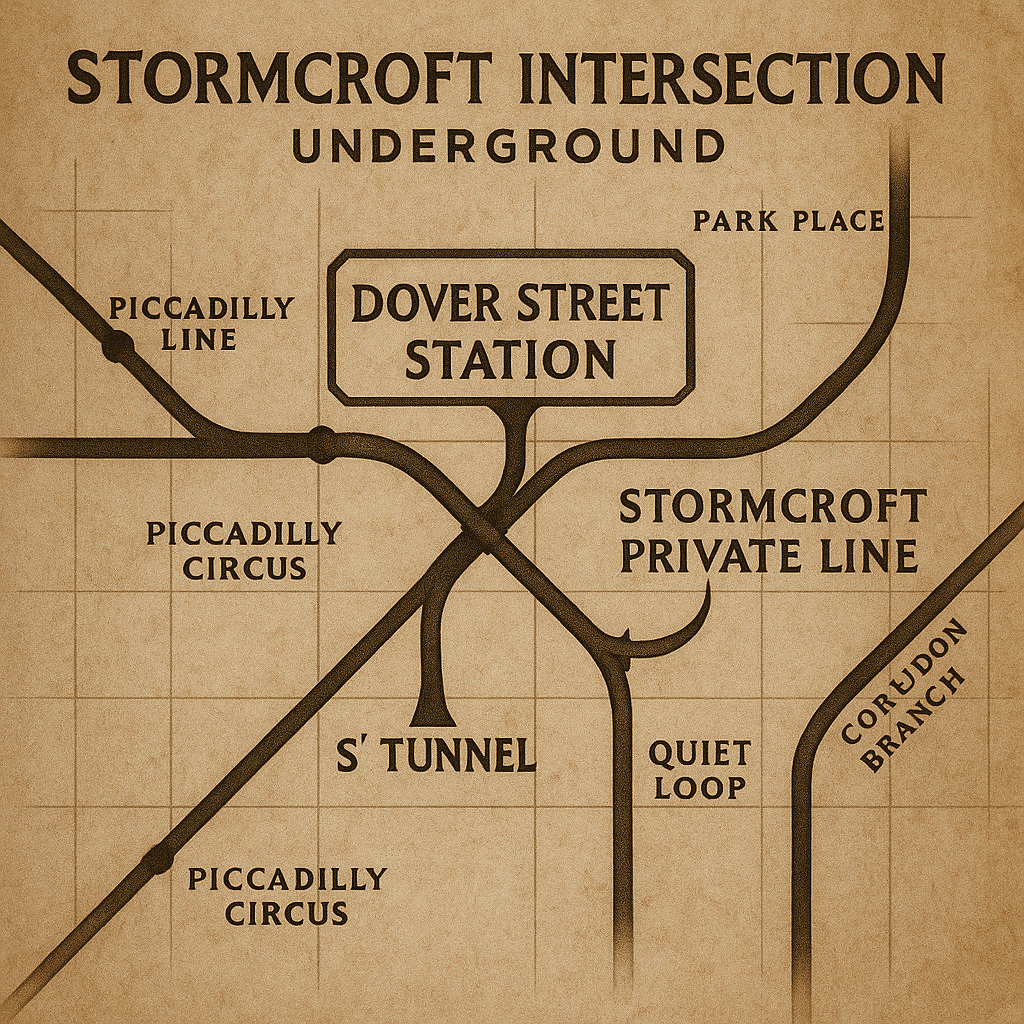
Opened in 1906 as Dover Street Station on the Great Northern, Piccadilly and Brompton Railway, it was renamed Green Park in 1933. The station underwent significant modernization, including the replacement of lifts with escalators and the addition of the Victoria and Jubilee lines. During World War II, it housed secure offices for the London Transport Executive Board.
Map Reference: The London Transport Museum’s collection includes a 1932 pocket Underground map by F.H. Stingemore, illustrating the station’s original layout and its connections within the network.
Image Description:
This vintage-style schematic map reveals the classified intersection beneath Dover Street Station (now Green Park) where the London Underground aligns with the covert StormCroft transit conduit. The main Piccadilly line is clearly marked, with a diverging tunnel labeled “Croft Branch 7-L”, veering east beneath the station’s deepest level — a zone unlisted in Transport for London records.
Annotations in Wren’s handwriting suggest the branch was reinforced in 1907 and used sporadically for memory crate transfer and fog-assisted subject retrieval. Faint topographic lines indicate an anchoring shaft known as the Hollow Root, believed to stabilise the echo-resonance during long-distance transfers from Taormina.
This intersection map was recovered in 1984 behind the defunct westbound lift shaft wall, sealed with a copper wax imprint bearing the StormCroft emblem.
3. Taormina-Giardini Station (Sicily, Italy)

Taormina-Giardini Station, inaugurated in 1928, is renowned for its Art Nouveau architecture and scenic location overlooking the Bay of Naxos. It serves as a key stop on the Messina-Syracuse railway line. Sicilia Secrets+1GPSmyCity+1GPSmyCity+1Transit Guide 112+ Countries+1
Map Reference: Detailed maps of the Taormina-Giardini station and its surroundings are available through Mapcarta, offering insights into its geographical context within Sicily. Mapcarta
Map Description:
This aged schematic map reveals the hidden subterranean junction beneath Taormina-Giardini Station in eastern Sicily, marking the only known foreign convergence of the StormCroft Underground Line. The drawing, dated 1890, depicts a fork beneath the standard Messina–Syracuse line, labelled cryptically as “Linea Silenziosa – No Entrata”.
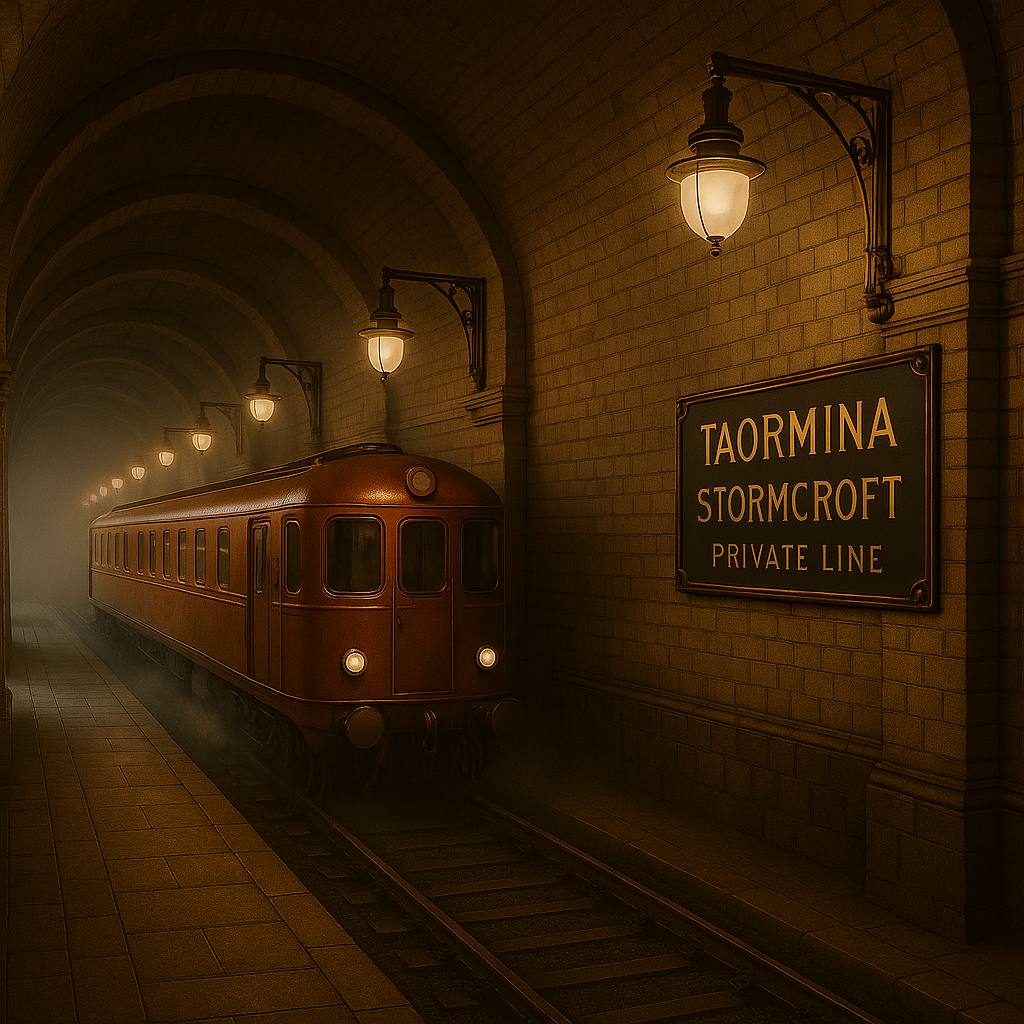
The StormCroft spur tunnels southwest beneath the hillside, marked with notations in a cipher used in Finch’s containment logs. A crescent symbol identifies a resonant convergence chamber, believed to be the first international echo loop field trial site.
Recovered from the storm-damaged archives of the Palazzo delle Ombre in 1937, the document was folded into a linen-bound case labelled “CroftNet Foreign Extension: Phase VI”. Taormina locals refer to the unexplored chamber beneath the station as “la gola che non parla” — “the throat that doesn’t speak.”
(image: This illuminated archival image reveals the subterranean platform beneath Taormina-Giardini Station, constructed in secret as part of StormCroft’s international spur. Bathed in soft Mediterranean daylight diffused through glass-tiled ceiling vents, the station retains its signature echo-dampened stonework, arched brick vaults, and polished signal tracks — designed for seamless transition between physical rail and Fog Transport-compatible locomotion. Notably absent of passengers, the image captures the stillness before activation, a rare moment of visual clarity within one of StormCroft’s most mythologised transport nodes. Copper rails gleam faintly under gaslit sconces, and signage in both English and Italian directs “cleared cargo” to Side B — a designation found only in CroftNet Phase VI manifests.)
Rowley Gant and the Taormina Studio Affair

Captured in their shared workspace on the outskirts of Taormina, this rare photograph offers a candid glimpse of Rowley Gant and Paolo, co-founders of the enigmatic photography atelier known as Vetrina Luce – Atelier di Silenzi. In the image, Rowley is seen adjusting a lantern near a filtered light reflector, while Paolo sits calmly among cases of photographic plates and fog-infused lenses — instruments unique to StormCroft design.
The studio, tucked into a low-walled villa beneath the hills, was reputed to produce portraiture that “reflected the memory of the subject, not the likeness.” Notably, this photograph was recovered from a sealed box marked SC–ITAL–LUMISIG/2 and is one of the few images believed to be developed using resonance-treated chemicals sourced from the StormCroft archive.
Visitors to the studio would later report the scent of copper and thyme — and that the room felt as if someone had just spoken… but left no words behind.
In 1903, a letter fragment filed among the last CroftNet dispatches of that decade included a detail long thought apocryphal:
“RG found — whole and humming. In sunlit exile. Studio in the valley — filled with boys and light.”
The fragment referred to Rowley Gant, the once-gentle, observational Hall Custodian at StormCroft House. Gant, who had not been seen since a quiet dismissal in 1893, had resurfaced ten years later in Taormina, Sicily, living under an assumed surname and reportedly cohabiting with the nephew of the local stationmaster at the secret StormCroft terminus.
Together, the pair had opened a modest but unusually refined photography studio at the edge of town, advertised discreetly under the name:
“Vetrina Luce — Atelier di Silenzi” (Showcase of Light – Studio of Silences)
According to private correspondences between former archivist Elias Dunbridge and a Sicilian CroftNet contact, the studio did not cater to tourists or traditional portraiture. Instead, it specialised in:
-
Staged “memory tableaux”
-
Fog-filtered plate photography
-
Echo resonance exposures — images designed to recreate sensations, not moments
The nephew, identified only as Paolo, is said to have served as both assistant and occasional model. Surviving letters imply he had inherited fragments of CroftNet glyph interpretation notes, believed to be passed via the stationmaster through unknown channels in the 1890s.
Notes from the Atelier
Recovered negatives (found in a crumbling leather folio labelled “SC–TRN–LUMI”) revealed:
-
Interior scenes lit only by refracted moonlight
-
Models posed in states of stillness “to attract remembered impressions”
-
A recurring architectural motif of arched tunnels behind every subject
Rowley himself was only photographed once — seated beside a brass lantern, hands folded, eyes closed. The caption reads:
“Memory must be taught to whisper, not speak.”
StormCroft’s Involvement
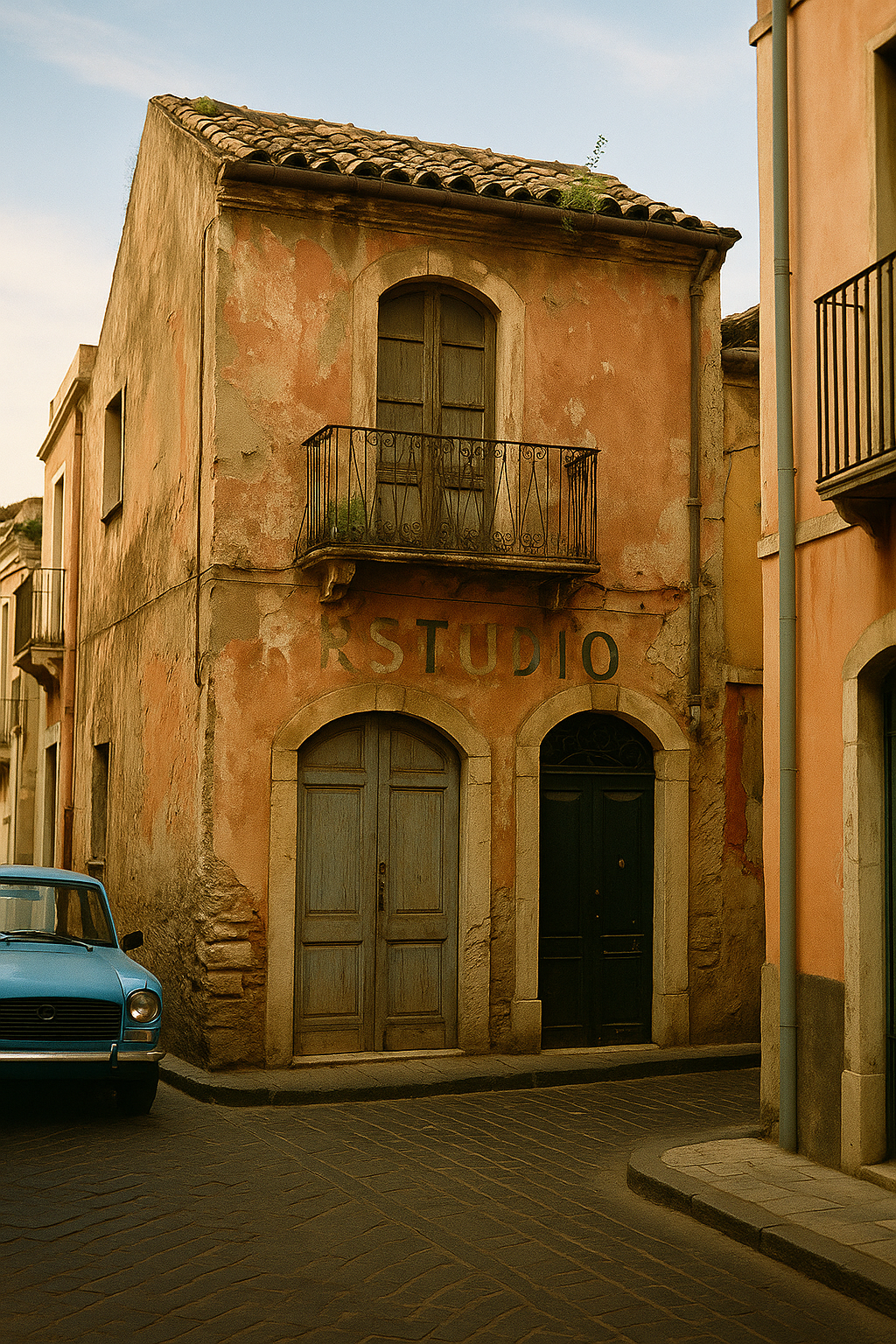
It remains unclear whether Rowley fled StormCroft or was permitted to leave under Wren’s direct instruction. What is confirmed is that a Fog Transport signal was detected beneath the Taormina studio on March 14, 1903 — the same day the gallery’s upper rooms were sealed for “renovation.”
Current Status
The original studio building, now derelict, still bears a faint copper inlay on the door lintel: a half-circle broken by three dots. A symbol last seen on Fog Transit manifests in 1889.
Of Rowley Gant, no further trace has been found. But witnesses in the 1930s claimed the studio’s window once lit itself — during storms — and on certain spring nights, a voice was heard in the courtyard murmuring:
“He sees in layers now.”
(Image description: This faded 1960s colour photograph captures the weathered façade of the former “Vetrina Luce” studio, nestled quietly along a narrow street in Taormina’s historic quarter. Once a discreet haven for echo-based photography and memory portraiture by Rowley Gant and Paolo, the building shows signs of sun-bleached stonework, rusted balcony rails, and shuttered upper rooms.
Local records indicate the studio officially closed in 1908, though residents claimed the upper windows would glow faintly during fog-heavy nights well into the 1950s. Faint remnants of painted lettering can be seen above the archway, spelling “ATELIER DI SILENZI”, almost erased by time — but not entirely forgotten.)
